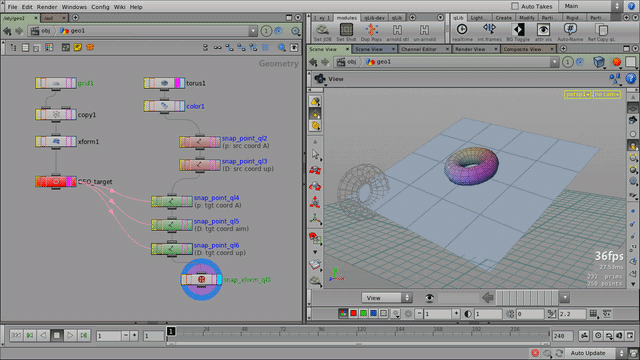interface version 2
Performs the transformations specified by previous Snap/Point qL SOPs.
This operator performs the snapping transformation(s) on the incoming geometry. The geometry should have reference point(s) set up (see Snap/Point qL SOP).

Procedural snapping: red nodes specify a source position and up vector (based on the torus geo), green ones set up target position, aim and up vectors (based on the grid). Then a Snap/Xform qL SOP applies the transformation.
Snapping is performed by specifying source and target point(s): the transformation will move the entire geometry to have the source point(s) exactly match with the corresponding target point(s). The transformation can involve translation (moving), rotation, and (uniform) scaling.
Tip
The transformation has two components:
from source to world origin (“source-to-rest”)
from world origin to target (“rest-to-target”)
These can be done separately, allowing for additional work to be done to the geometry while it’s in the world origin position.
Snapping types
The following snapping options are available, based on the number of points and/or vectors (directions) specified.
| Single point (point A) | Translate-only snapping. |
| Two points (points A/B; point A / aim direction) | Translation; rotation; uniform scale. |
| Three points (points A/B/C; point A/B and up vector; point A and aim/up vectors, etc.) | Translation; always-accurate rotation; uniform scale. |
Attributes
The following (detail) attributes are used for storing snapping points:
__src_coord_A__src_coord_B(or__src_coord_aim)__src_coord_C(or__src_coord_up)__tgt_coord_A__tgt_coord_B(or__tgt_coord_aim)__tgt_coord_C(or__tgt_coord_up)
The _aim vectors represent the direction and distance from A to B; the _up vectors are for A to C.
Parameters
...
Release Notes
interface version 2 —
| 2014-02-26 | First prototype, with reworked UI. |
interface version 1 —
| 2013-05-14 | First prototype. |